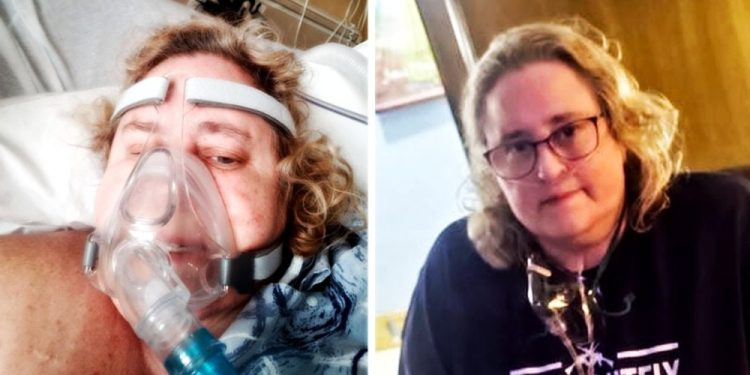This article was originally published by The Defender — Children’s Health Defense’s News & Views Website.
In late 2021, Gail Seiler was enjoying life with her husband, adult children and her grandchildren. She was happily employed as a technology manager near Dallas after spending several years living in Europe.
All this changed in December 2021, however, when Seiler said her “nightmare began.” On Dec. 3, 2021, two days after testing positive for COVID-19, low oxygen levels led her to go to her local hospital, Medical City of Plano, Texas, for treatment.
Unbeknownst to Seiler or her family, this would mark the beginning of a 13-day ordeal of being subjected to what she described as “cruel and inhuman” treatment. Seiler was denied nutrition and medications and was listed as “Do Not Resuscitate” (DNR) — despite repeated insistence to the contrary by her and her family.
In an interview with The Defender, Seiler, now 55, said the hostile treatment at the hospital began when doctors there learned that she had not received a COVID-19 vaccine. It culminated when her family, following a “standoff” in her hospital room, succeeded in removing her from the hospital and taking her home, which Seiler said saved her life.
Despite her doctors’ insistence that she would die if she left the hospital, Seiler says she has fully recovered. She credits medications such as ivermectin in helping to save her.
Seiler’s experience motivated her to get involved with a nonprofit group, the FormerFedsGroup Freedom Foundation, campaigning to raise awareness about COVID-19 protocols sanctioned by the Centers for Disease Control and prevention and the harms they caused. Seiler shared extensive documentation with The Defender to corroborate her story.
‘The first question he asked me was if I was vaccinated’
Seiler told The Defender she went to the Medical City of Plano because it was the closest hospital to their home and also where prominent Texas politician and former gubernatorial candidate, Col. Allen West and his wife had received the America’s Frontline Doctors treatment protocol there.
The protocol included “hydroxychloroquine, ivermectin, and budesonide along with vitamins,” she said. West was not vaccinated for COVID-19, and Seiler said his illness received extensive media coverage connecting his illness and hospitalization to his unvaccinated status.
Intending to receive the same treatment, Seiler said her husband printed out a couple of copies of the Frontline Doctor protocol and took them to the hospital with her. With her oxygen level at 77, Seiler was taken to the emergency room, but was not seen for at least an hour. When examined, Seiler gave the nurse a copy of the protocol and was told “yes, we’ve done this protocol, we can do this protocol.”
Instead, “They just put me on some oxygen,” she said.
Seiler spent 26 hours in the ER before being admitted to an ICU on Dec. 5, 2021, where she was examined by Dr. Giang Quash. “The first question he asked me was if I was vaccinated,” she said.
Quash responded by telling her, “I’m so sorry Mrs. Seiler, but you are going to die,” and that her only options were to receive remdesivir and be placed on a ventilator — although even with that treatment, he said she was going to die anyway.
Seiler told Quash he was fired, but since he gave her a terminal diagnosis, she wanted her priest and she cited the Right to Try Act — and demanded she wanted to “try Ivermectin and Budesonide.”
Seiler said her husband, a former military nurse, “was very well informed about the mRNA technology and what it can do, and he questioned the speed to deliver [the COVID-19 vaccines] and the lack of informed consent obtained from patients.”
-
Learn the TRUTH about Gold IRAs and how most precious metals companies play dirty.
Seiler also had already had COVID-19 and “recovered fairly quickly” from it without hospitalization, and that as a result, she “wasn’t afraid of it.”
‘Cruel and inhuman’ treatment
Seiler said she knew Quash was “gaslighting me,” and immediately delegated all decision-making responsibility regarding her health to her husband, who was also “shocked” that she had been told she would die.
“I didn’t want them to say to my family, if they killed me, ‘Oh, she agreed to this’ or that ‘she agreed to death’ or ‘she agreed to be put on a ventilator.’ I didn’t want that to happen.”
Instead, Seiler and her husband insisted on receiving hydroxychloroquine, ivermectin and budesonide, as well as vitamins. However, “They said no to everything,” she said, ignoring her requests even when she referenced the Right to Try Act or requested a copy of her rights as a patient. Seiler said that what followed instead was “cruel and inhuman treatment” with numerous examples of abuse.
Seiler said that the doctors and nurses claimed they were unfamiliar with the Frontline Doctors protocol and “would demonize ivermectin.” Instead, she was placed on a BiPAP machine, which Seiler said “blows hot air, forced air, into your lungs,” which she described as “excruciating and unnecessary.”
She also was denied basic nutrition, water and personal care.
“Even though I was more than capable of drinking,” Seiler was denied water for seven days and received “no nutrients for the first 11 days,” after which she “finally got a banana bag as per my daughter’s persistence.”
Seiler said her husband was able to bring her Ensure, but that it was placed “out of my reach” in the hospital room. After receiving no mouth care for 13 days, “I was developing thrush,” Seiler said, , “and was starting to get worse,” having developed a film covering her teeth that “required medication to clear up.”
In addition, Seiler said she was forced to have a catheter on her first day in the ICU, which was subsequently never cleaned, leading to an infection. Doctors also “started loading me up with diuretics, so that I could not control my bladder or bowels,” she said, also described receiving “very little cleaning up,” leading to matted and lost hair.
She also was denied physical therapy.
Some nurses were also particularly harsh in their treatment toward her because of her unvaccinated status, according to Seiler, sharing one example of an “nurse who was literally very cruel” The nurse did not respond to Seiler’s calls for over 20 minutes after a cord connected to her oxygen machine came loose. She was forced to hold it in manually so it would work.
According to Seiler, when the nurse finally came in, “she hit me, slapped me on the shoulder, grabbed the cord, and said ‘I can’t come in here very much because you’re unvaccinated and you have COVID.’” Seiler said her response literally was, “If you’ve gotten the shot [but] are too afraid to come in my room, it reinforces why it was right for me to refuse to get the shot.”
Seiler also said she was administered insulin, despite not being a diabetic, and that she wasn’t told if there was a medical reason for this. When administering the insulin, the nurse “would plunge the needle into my stomach,” recounted Siler “I had so many bruises all over my stomach. It was horrific. My husband was livid when he saw it.”
“She was very aggressively harmful,” Seiler said. “I call it medical battery.”
After two evenings of this, Seiler said she could take no more. “The third night she came in, I thought, ‘dear God, I can’t do this. This woman’s going to kill me.’” Seiler texted her daughter, telling her she was “terrified” of her nurse and worried “she’s going to kill me.”
After her daughter submitted a complaint, the individual in question, a travel nurse, was switched out with no explanation.
At one point Seiler and her daughter requested high-dose vitamin C, only to be told there was a “national shortage.” The hospital would not let her daughter bring Seiler’s vitamins from home, instead only giving her “a kind of a child vitamin. “A high dose alone makes a huge difference — it saves lives, Seiler said.
Even when Seiler was eventually granted vitamin C, she said the dose administered was lower than recommended.
“Protocol is one milligram every four hours through a nebulizer,” Seiler said. “And they would only do one milligram every 10 hours,” noting that the hospital pharmacist overruled the protocol and “would not allow it,” despite not having examined her.
Even with such a reduced dose though, Seiler began to show signs of recovery and was told by Quash “I’ve never seen this before.”
“I thought, well, he’s seeing the light,” Seiler said. But when she asked him if her Vitamin C dose could be increased to protocol levels, her request was denied, as were her requests for “medications that I needed to fight pneumonia.” Seiler said these requests were denied “with no explanation” even for medications “they promised to give.”
Seiler said that her medical charts listed her as a “DNR” despite repeated insistence by her and her family members to the contrary. Even after her attorney intervened, “They wouldn’t change it,” Seiler said, although in notes accompanying her medical chart, “they acknowledged that I’m saying I’m a full code.” Yet, “on the chart, which is what they’re going to look at if something happens, it says ‘DNR.’”
Instead of her requested treatment, Seiler was told that if she agreed to take remdesivir, she would be permitted visitation from her priest.
“Our faith is very important to us,” Seiler said, “and so we agreed.” However, when her priest was called away to an emergency on the night of his scheduled visit, the doctors administered the remdesivir anyway, she said.
“So, they got one round, which you know, we knew about the hospital bonuses,” Seiler said, referring to bonuses given to hospitals which administered the COVID protocol, including remdesivir, to COVID-19 patients. “They got their 30 pieces of silver, right?”
‘If I stay here, they’re going to murder me’
After 13 days, Seiler said her husband and daughter “made the bold decision” to remove me into home hospice care so that I would have a chance to live,” adding that they had made arrangements with a private company “to set up a 7-day support and care plan.”
“The hospital made this very difficult for us to do,” Seider said. “They tried to deny it, block it, scare me into staying … I asked many times if I was a prisoner or a patient.”
“I knew that I wasn’t going to die of COVID,” Seiler said. “I felt I was going to be murdered in this hospital. … I wanted to go home, even if I died.”
On Dec. 14, 2021, Seiler’s husband arrived at the hospital with copies of two Texas laws, House Bill 2211 (“Relating to in-person visitation with hospital patients during certain periods of disaster”) and Senate Bill 572, which includes provisions allowing clergy to visit hospital patients. However, “they would not let him in,” she said.
Following this, the local sheriff and police were called, but according to Seiler, “They wouldn’t enforce the legislation.” Instead, officers stood guard at the door to her hospital room. Seiler said she told the officer “If I stay here, they’re going to murder me,” but that in response, the officer left without taking any action.
Early in the morning on Dec. 15, 2021, Seiler’s husband called her and asked if anyone was in the room. Hearing there wasn’t, he said he was going to “come to save my life.”
In a stroke of good fortune, Seiler’s husband encountered open doors and no security upon arrival at the hospital. Dropping off a cease-and-desist letter and copies of the two Texas laws at the entrance, her husband was able to make it all the way to the ICU unit. “They couldn’t stop him,” she said.
Hospital personnel soon arrived and informed her husband that he “needed to leave, to get out.” However, his response was “I’m not leaving this hospital without her. You’re not going to murder my wife. She’s not your guinea pig. I’m taking her home today.” Following this, a “standoff” began, as Seiler described it.
Eventually, the hospital and police offered to allow Seiler release “against medical advice” (AMA) instead of home hospice — which Seiler refused. There were legal distinctions at play here, according to Seiler, since if an AMA form is signed, insurers can deny payment for treatment.
Seiler recalled telling hospital personnel that she did have medical advice from outside doctors advising her to leave, noting that the hospital itself had said she “was terminal.” According to Seiler, her husband was able to alter the release forms the hospital provided, “crossing out things,” and she signed it. Her husband also furnished a small bottle of oxygen to sustain her for the trip home.
‘As soon as you walk in the hospital, you are a paycheck’
Despite her ordeal at the hospital and her poor physical state upon leaving the hospital, Seiler said she did eventually recovered fully. She began taking ivermectin and budesonide and was connected to a larger oxygen tank at home, in “a scary 72 hours getting me titrated off the oxygen.”
“When my husband drove away from the hospital, that was the first time I felt I was going to live during the whole experience,” Seiler said. “And it wasn’t easy. I was a mess … I couldn’t walk. We had to have a wheelchair and walker … I couldn’t eat … I lost a lot of hair.”
She said it took months to recover but she has no lingering physical aftereffects from her hospital experience. “Just yesterday, I did … elliptical and swam,” she said. However, she noted that from an emotional perspective, she was obliged to start counseling and therapy for the effects of PTSD.
Seiler explained why, in her view, she received the treatment that she did:
“Had I been given the ivermectin and budesonide at the hospital instead of them pushing only the harmful option of remdesivir and ventilation, my stay would have been very short. Instead, the doctors and the hospital administration made an early decision that I was going to die.
“They get a lot of money from the CARES Act if they give you remdesivir and more if they ventilate you. That combination gives you a 12% chance to survive!
“But they also get more money if they can put COVID-19 on your death certificate. It’s very lucrative for them. The bonus of killing the unvaccinated is in driving up the statistics. You can’t prove a pandemic of the unvaxxed unless you can drive the death count up by killing the unvaxxed.”
For Seiler, a silver lining in this experience is the advocacy work she now performs on behalf of hospital protocol victims and their families.
In March 2022, Seiler joined the FormerFedsGroup Freedom Foundation, which had launched a citizen task force and the COVID-19 Humanity Betrayal Memory Project (CHBMP), which describes itself as an effort to build “a living archive of ongoing Crimes Against Humanity.”
Through this organization, Seiler said “we have heard from tons of people” and “have documented many stories,” over 1,200 in all, although “most are not survivors” but instead, family members of those who didn’t survive.
CHBMP has compiled a list of 25 commonalities shared by many of the victims whose stories the organization has documented. According to CHBMP, commonalities include isolation of the victim, denial of informed consent and alternative treatments, gaslighting, removal of communication devices, discrimination against the unvaccinated, dehumanization, dehydration and starvation, non-emergency ventilation, refusal of transfer and strict adherence to Emergency Use Authorization protocols.
Citing CDC statistics, Seiler said 1.6 million people are listed as having died of COVID-19, influenza or pneumonia — out of which only 167,000 died at home.
“The rest of them died in facilities, hospitals, some type of inpatient setting,” Seiler said. “And so, that’s where you start looking. … That tells you, look at the protocol,” along with “the isolation, the overall treatment. … They’re kind of thrown into these units like animals. It’s just incredible.”
“As soon as you walk in the hospital, you are a paycheck,” Seiler said. “You have a target on your head from these bonuses. So … you’ve just walked into basically a prison … and they’re not letting go.”
FormerFedsGroup also launched a public awareness campaign, according to Seiler, with billboards placed in Michigan and New Jersey, asking people to question the deaths of loved ones attributed to COVID-19 and directing them to the CHBMP website.
Seiler said that the FormerFedsGroup’s citizen task force has approximately 125 volunteers, who are “mostly victims turned advocates fighting for justice and change.” She described them as “eyewitnesses to crimes against humanity” who “lived through it and are not going to sit down and take it” and are instead sharing their stories.
Support groups for victims and their family members have also been organized. “It’s empowering” to connect with others who “have said the same thing” and who “see that they’re not alone,” Seiler said.
Seiler advised victims and their relatives to “not let anyone else silence you. Tell your story as much as you know it and connect with others. Don’t just take this. Be brave. We can help you.”








